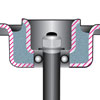Strut Mounts: the unsung hero. Keeps your ride quiet and vibration free.
As the name (strut mount) implies, it’s a component that attaches the suspension strut to the vehicle. In addition, it insulates the tire noise & vibrations from the vehicle. Many (front) strut mounts also contain a bearing or bearing plate that serves as the steering pivot.
A strut mount is like a sandwich. One side bolts to the vehicle, the other side to the strut. In the middle is a rubber-like insulating material. So as the vehicle moves and goes over bumps, the up & down impact pushes and pulls at the mount. The mount’s job is to cushion the impacts to reduce the jarring effect, noise and vibration that could transmit into the vehicle.
On many front struts, the mount also includes a bearing that the strut attaches to. With one on each side of the vehicle, these bearings act as the steering pivots. The bearing is a critical component that affects steering movement smoothness and response.
Why replace it?
There are two main reasons; age changes the density of the insulating material so more noise and vibration can be transmitted into the vehicle and the bearing portion of the mount wears.
When to replace them?
A simple rule of thumb is that if the struts or coil springs are being replaced because of age or wear, then also replace the mounts. A worn or damaged mount can cause a variety of symptoms so they should be inspected by a qualified technician. Disassembly of the entire strut & spring assembly is required to remove & replace the mount. Therefore replacing all worn components at the same time could save you from doing the work a second time.
How to tell if the mount is worn. Drivability symptoms may include:
- Clunking noises
- Vibration
- Loose, stiff or noisy steering
- Tire alignment
- Tire wear
Visual indication of a worn mount may be:
- Loose or damaged components
- Excessive movement
- Cracked or sagging rubber
- Corrosion
